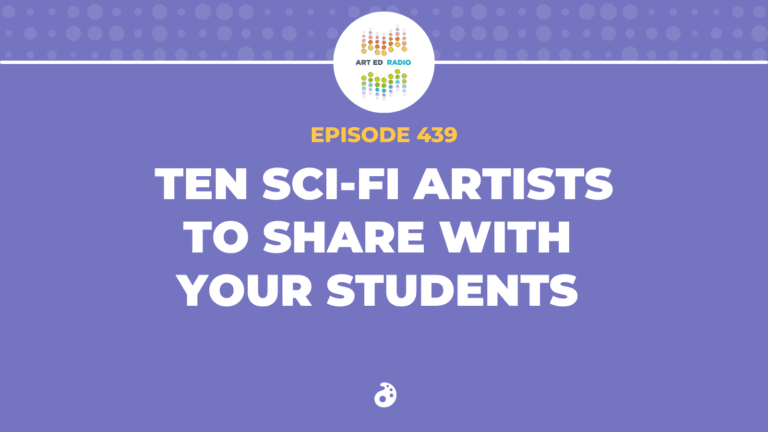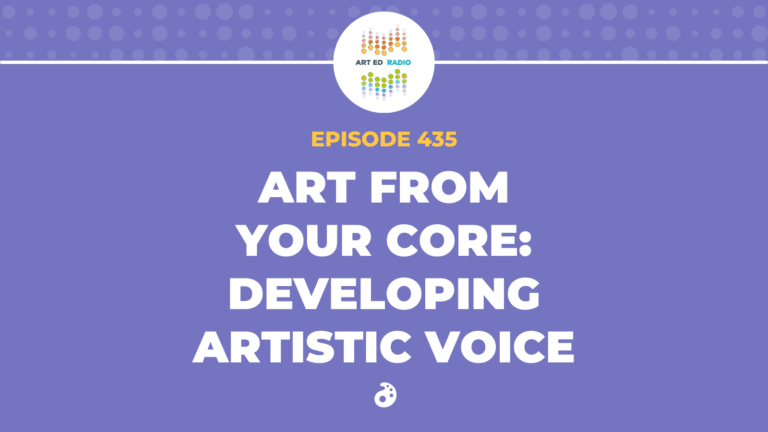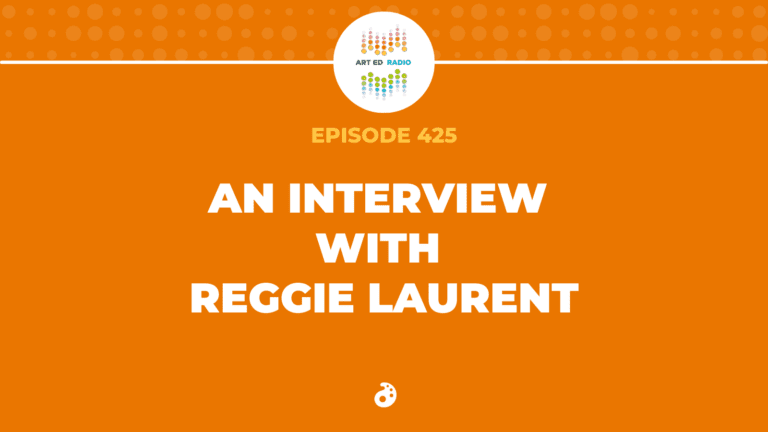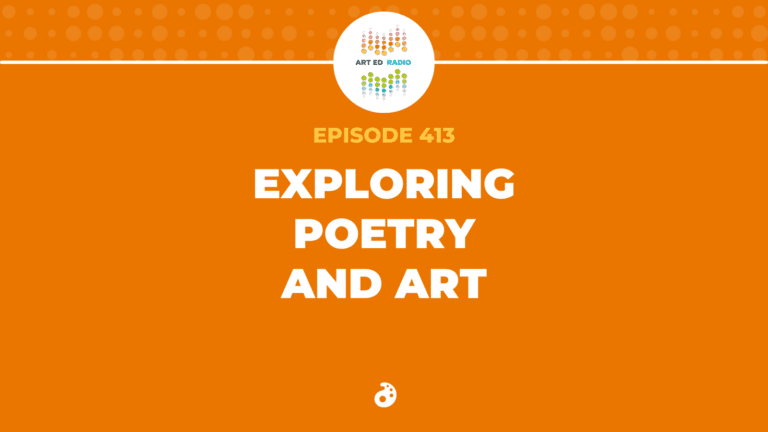Art Class Curator podcast host Cindy Ingram is doing a podcast swap with Tim this week! She is a guest on Art Ed Radio today, and he is a guest on the Art Class Curator podcast as well. In this episode, they discuss teaching art history, why emotion plays such a big role in Cindy’s passion for art history, and give some strategies on how to better teach art history in your own classroom. Full episode transcript below.
Resources and Links
- The Art Class Curator Website
- All of Cindy’s Podcasts
- Art History Ideas on AOE
- Tim’s Favorite Art History Podcast Episode
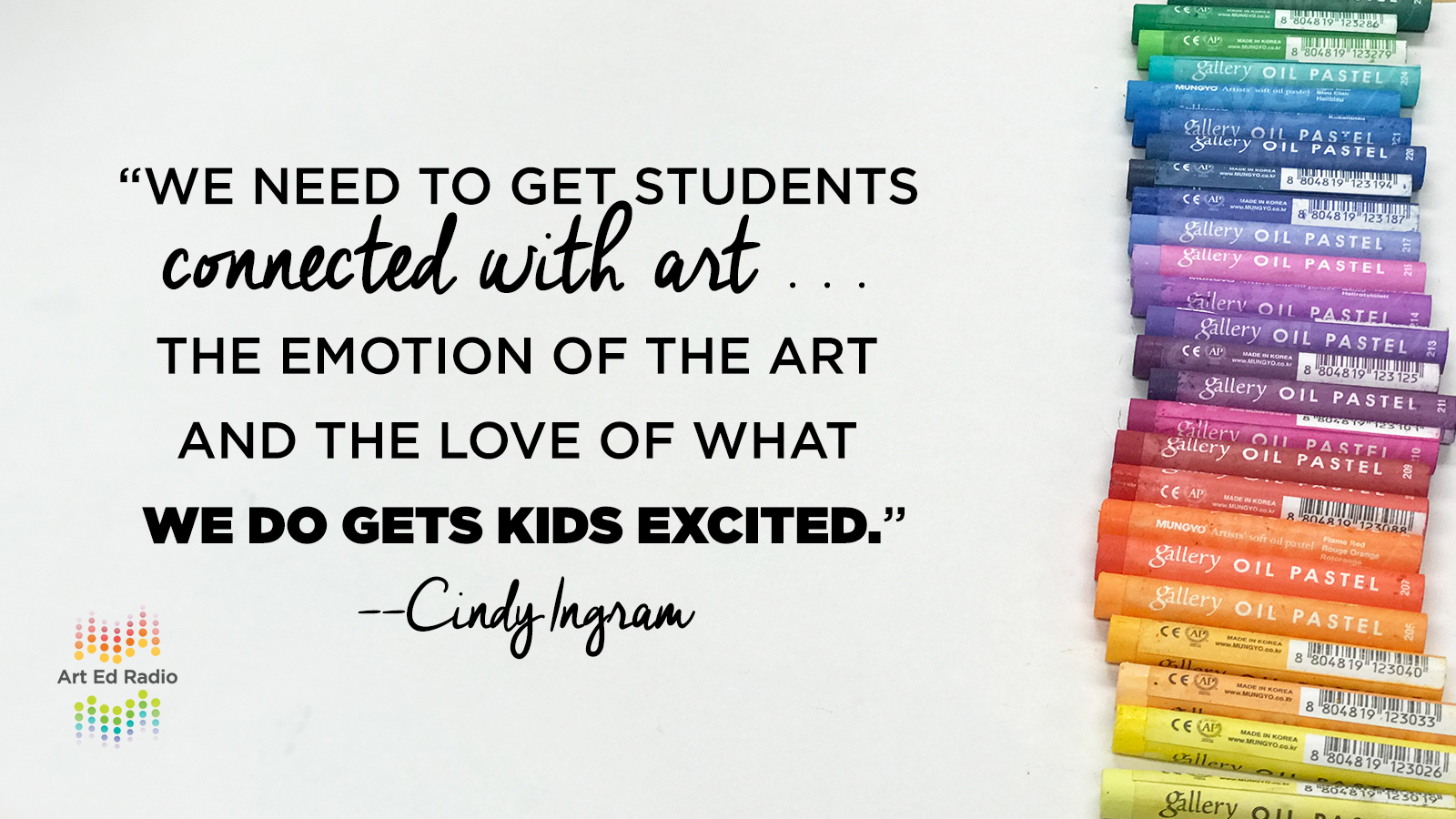
Transcript
Tim: Welcome to Art Ed Radio, the podcast for art teachers.
This show is produced by the Art of Education and I’m your host, Tim Bogatz.
All right, it is art history week. I mean not officially art history week, but we’re going to be talking about it a lot. And I think everybody who listens to this podcast on any kind of a regular basis knows how much I love art history. It is absolutely one of my passions when it comes to teaching.
I love the storytelling behind it, I love learning about the history, the artist, everything that goes on and we’re gonna really kind of go in depth, today’s guest is Cindy Ingram, who runs the Art Class Curator website and hosts the Art Class Curator podcast and her site is just an awesome one that gives you all kinds of resources and inspiration for teaching art history.
So if that’s something you’re interested in, make sure you check it out once you’re done listening here. And also exciting is we’re doing kind of a podcast swap. So I’m on an episode of the Art Class Curator podcast this week, and obviously, she’s going to be here on Art Ed Radio.
So if this episode and this interview isn’t enough art history talk, make sure you go and listen to that one as well, and I think we went way too long there, another 40 or 45 minutes of discussion there, but if you really need to like get in depth with how I teach art history, all the artists I love and everything that goes along with it, go check that out.
There’s also a good story, Cindy apparently has been holding a grudge with me for about four years about something bad I said about Picasso in an article like back in 2014 so we had to hash that out as well. So it’s kind of an enjoyable one.
But before we get started with the interview here, I also want to tell you about the Art of Ed’s Integrating Art History graduate course.
So if you love art history already or maybe you are at the opposite end of the spectrum, you don’t love it, but you’re looking to learn more, or looking to do more in your classroom, you know, that is the place to go. Integrating Art History.
Now we know that a lot of teachers struggle when it comes to making art history relevant in your classroom, okay? But this class will help you create the strategies you need to make art history personal and make it meaningful and make it memorable.
And no matter what age you teach, you know, those types of strategies that you learn in this course and take back to your classroom can give your kids a lifelong appreciation of art. So if that’s something that interests you, check it out at the artofed.com/courses. Again that’s called integrating art history and the newest section starts in just over a week here at the beginning of November.
Let me bring on Cindy and we will get our interview going.
And Cindy Ingram is here with me now, Cindy how are you today?
Cindy: I’m doing great, thank you so much, how are you?
Tim: I am doing really well, I’m excited to chat with you.
And to start about, you know, I wanted to talk about Art Class Curator. Can you kind of explain what it is, what you do and where it came from for you, like how it got started, how it’s grown and kind of what you’re doing now, what you’re doing at this point?
Cindy: Sure. Well, I used to be a museum educator, I have a degree in art history and when I started teaching, it was teaching community college art appreciation class, I would constantly be Googling things like, you know, examples of artworks to show line or creative ways to teach the renaissance or things like that. And I could never find the thing I was looking for.
I couldn’t find a lot of information about artworks or artists, I could find projects but I couldn’t find how to actually teach art history and art appreciation.
So eventually, I just created my own curriculum from scratch and then I eventually decided to just make the thing that I had been looking for. So I started writing about art and I started writing about how I teach art from sort of a former museum educator perspective, which is a lot of discussion and interpretation and engagement with art rather than just telling about the art.
So it really focuses on creative ways to teach art history and art appreciation. And it started as a blog with me talking about those things and then I started to sell some of these lessons that I created during my career and then now I have a membership site where people join and they get art history and art appreciation lessons and resources to use in their classroom.
And I also have a podcast and I still have the blog, and I have a weekly newsletter, as well.
Tim: So you have a lot going on, is what you’re saying?
Cindy: I do, yes. I do all the things.
Tim: But I wanted to chat about the podcast too, because we just finished an interview for that podcast, it’s an exciting home and home switch here, so, this is good, but can you tell people a little bit about how you started the podcast and maybe what people can expect if they were to listen to that?
Cindy: Sure, I have always, in the back of my head though I would like to do a podcast but I never felt like I would have the stamina to keep it going and I was worried I’d run out of content and things to say, but in the end, I do prefer to talk more then I prefer to write, so when I was at NAEA this last spring, in Seattle, I was sitting in a session, one of the two sessions I went to.
I was sitting in the session and I was like “You know what?”, there are these four museum educators presenting about this thing, and I was like “you know, I could interview each one of those,”, and I was like “and I could interview every single person at this conference,” and then I realized all the people I’d been meeting, they all had unique stories to tell and I got really excited and I planned my podcast from that session instead of listening to the rest of it.
So, then I started it right when I got back.
Tim: Yeah, that’s awesome. That’s cool when you can find that kind of inspiration that… Especially when it’s things you’ve been thinking about for a long time, things that have been kind of in the back of your mind, like when you can put those into action, like, that’s when inspiration strikes, that’s always good.
Cindy: Definitely. Oh and you know, I didn’t answer you “what can people expect if they were to listen,”.
I want people to… My whole goal is really to get people connected with art and to get your students connected with art, so I really focus on the emotional side of art and the connection and the love of teaching and the love of art and the love of what we do, so I really try to focus as much as I can on those things.
What makes us really excited about our jobs and thoughtful about our jobs.
Tim: Yeah, that’s good. Obviously, you know, the episode we just recorded, you and I together is going to be the best episode.
Cindy: Obviously. Yeah, my favorite so far.
Tim: But besides that one, have a favorite episode or two that you would recommend to people who maybe want to try it out or want to listen for the first time?
Cindy: I do. I have an episode with Jim O’Donnell, and he’s been on your podcast before.
Tim: Yes, I love Jim.
Cindy: He is just so brilliant and has so many great ideas, I really loved his conversation with him, we talked about all sorts of different things. So if you’re interested in sort of checking it out, I would say start with that one, that one was excellent.
And then I also enjoyed… I have enjoyed so many of them, but I loved talking with Megan Hildebrant. She runs a program in her school connecting with a cancer center and she has her students go into the cancer center and work with the cancer patients and I really loved the conversation with her.
But I really have loved every conversation in its own way. But those were the two that sort of stand out off the top of my head.
Tim: Yeah, and I loved your conversation with Don Masse, because Don’s just awesome and he has such a fascinating story to tell and he does so many cool things in his classroom, so that’s always fun.
But you know, I kind of wanted to talk a little bit about art history too, because you and I kind of dove in deep on your podcast about some of our favorite artists that we love and even a few artists that we hate, which is fun.
But I think we have those emotions going strong both ways because we have such a passion for art history and for teaching art history. So if I can ask you, where did this come from originally, like how did you learn to love art history?
Cindy: Well I grew up wanting to be a Disney animator, I always loved to draw, but I… It was really the connection with I would watch the movies and I’d feel emotionally moved by then. And I didn’t know it at the time, but I was being emotionally moved by art and I just didn’t quite make that connection.
But it wasn’t until I was in high school, I went on a Europe trip, my junior year English teacher took a group of students every summer for a month and you went pretty much everywhere in Europe and there was a class leading up to it, you got college credit, it was just really intense and very much focused on art history.
And I’m coming from a small town in Texas where we didn’t… Well we did have an art museum, I didn’t know about it until after I left, but I never saw real works of art ever in person, and my art teachers didn’t show us art that often and then I got up there and I’m like “people see this every day,”, you know, this is something that is part of people’s lives and I never looked back because I decided that trip, I was like “I’m gonna study art, I’m gonna do art history,”.
And I didn’t know what I could do with it, but I just knew that I needed to be emotionally moved by art for the rest of my life.
Tim: Wow, that’s such a good experience. And actually, if I can follow up on that, I know you’ve traveled more than that, too. Can you talk about, I guess not only where you’ve been but what you learn, or what you see or what you feel by going to all of these different places?
Cindy: Yeah, I just, I love to travel, and it’s one of the reasons I started my website to begin with because I wanted it to be my job so that I could do my job from anywhere, it was really one of my main goals. And then also, in that first Europe trip, I decided, I was like “I wanna take people to Europe, that’s what I wanna do with my life, that would be amazing, and teach them the art while we’re there,”.
And it was actually 20 years to the month I took my first trip, this last summer with readers and members from Art Class Curator. So it was really exciting.
But when you go somewhere, your world is opened up, your eyes are opened up to other people and it makes you more connected I think with the world and with other people and it’s about the art, yes, and seeing the art in person is so different than seeing it in a reproduction, but it’s more about becoming a citizen of the world to me.
That it’s about being curious and excited about the world, and understanding that everybody in the world is good and kind and wonderful and, I don’t know. It’s hard to explain, but I just think everyone need’s to do it, because it’s so powerful, in a way that’s hard to explain.
Tim: I think that art is so inherently tied to culture that there’s a difference between seeing reproduction, seeing it where you live and actually traveling to the places where this art comes from and where this art is located now. And I think being able to experience the culture along with the artwork makes you… I mean it really does accomplish that goal of being a more global citizen and being a more curious person, because you have such a better understanding of what’s there and where it came from.
And so I think-
Cindy: Yeah, definitely.
Tim: I think my social studies teaching wife would be very proud of me for that, but I mean, no, it is. Those are the common goals, we need to be curious, we need to understand other cultures, other places, other ideas and I think there’s a lot of value in that.
But if we can talk about specific artists, you know, if you wanna share a couple that you love to teach, I know readers or listeners always appreciate getting those new ideas, but I also wanted to ask you like, who’s an artist that you think maybe doesn’t get enough attention or an artist that you think more students should study?
Cindy: The artist that comes to mind, and I’m actually kind of bummed that it’s not a woman that came to mind first, but I wish it was. I love David Siqueiros, which he’s a Mexican modernist artist, and he does these really intensely personal and intensely powerful paintings. He does large-scale art like Diego Rivera and stuff as well, but his smaller paintings are just really… there’s something about them that get to the inside of you and just like make you wanna weep for the world.
And I think that anybody who can make someone feel that way needs to be studied more, more often. They’re so beautiful and powerful.
Tim: Yeah, I was just gonna say, like powerful is the word that comes to mind when I’m thinking about or when I visualize his work.
And I think it’s fairly easy for people too, to incorporate him because I feel like just about everybody teaches Frida and once you teach Frida, you usually teach Diego along with it.
But then, I mean, he’s a contemporary of both of them and being able to kind of tie in his work with what they did is a very simple connection to make and I think a lot of people can do that without too much trouble.
But let me ask you also, like who are some other artists that you really love to teach besides them?
Cindy: I love to teach African… The Nkisi N’Kondi power figures from the Kongo people, Kongo with a K.
They’re… It’s not an artist, I know, but I guess it is an artist, not a specific person artist. Those are so powerful again, I tend to go for really emotionally powerful things.
But they are little figurines, like maybe three or four feet high wooden sculptures and they have a bunch of nails hammered into them and then they have a hole in the stomach where they would put medicines and herbs and it’s usually covered with a mirror or a shell, and then the facial expressions are really sort of dramatic.
But they’re basically like hunting figures, and when you are in… If you have a promise, then you put a nail in, and then if you break that promise then the power figure will come after you and hurt you in some way. Like it’s basically like a keeper of treaties and promises and vows and things like that.
But those are really fun to talk about with students, they really love them because they’re so cool looking but then they have all this extra cool meaning and you can really understand their culture through exploring those, so I love to look at those as well.
Tim: Yeah, no. Those are very powerful figures and it’s something I wish I would have taught more when I was in the classroom, but they are, I don’t know like you said, they’re so rich with detail and with stories behind them and I think that always makes for good opportunities for teaching.
Cindy: And the students can figure it all out just by looking at it, which I love art where the students can do all the work and they can figure out what it’s about just through engaging with it, that’s always.
Tim: Yeah. And you know, you’ve talked a couple times now about how you’re kind of drawn to the emotional side of artwork but you know, I wanted to ask you about how that translates into your teaching, I guess?
You know and maybe just chat a little bit about the logistics of how you teach art history, can you talk about how you’ve done it, what you’ve found is effective for you and maybe give a couple tips for teachers that they can take back to their classroom?
Cindy: Sure. I think it’s important to find art that is fascinating and relevant and that you’re excited about. I call it the three Cs when I teach on my website. It has to be compelling… Oh, I always get that word, it’s not compelling, it’s another C word. It means compelling. Anyway, compelling, communicative and complex. That it’s an artwork that just genuinely makes you curious about the world and it makes you feel something.
So I like to say you’ll start with something that is just really exciting and engaging, because then if you’re excited about it and you’re curious about it, that’s gonna rub off on your students. Because my goal is to make every student have some sort of personal connection with an artwork in the time that I have with them.
And maybe it’s only one, but that artwork is gonna stay with them forever and they’re gonna remember it, and they’re gonna remember the experience they had with it and they’re gonna remember the passion that you showed when you taught about it, and they’re… You know that is gonna be a part of them.
And so I think we need to make art exciting for our students. And so and I also think it’s important to let the students do as much of the thinking that they can, instead of just putting up and artwork and you telling about it, that you are asking them what they think, having them tell the story, having them figure it out, and you can ask some questions to get them thinking, but let them do all of the work. Because we are not used to thinking, we are used to Googling and finding the answer and we need to slow down and let our students do as much of the thinking and interpreting as they can.
So yeah, I incorporate this a lot in my classroom, and I had the joy of, for many years of my teaching, to only teach art appreciation and so I got to do that all the time and so that’s all I did but, yeah. That’s what I’d say.
Tim: Yeah. That’s awesome, that’s really well said, and I think that’s really good advice about, you know, how to approach it and what kids can find, what kids can take out of it.
Well I think that would be a good place for us to wrap it up, so Cindy, thank you so much for coming on and chatting with me, it was great to talk about art history and hopefully, we can get together and nerd out about art history sometime soon.
Cindy: Indeed, thank you so much.
Tim: That was an awesome talk with Cindy. I love hearing from her about you know, not only the strategies for her classroom that we kind of talked about, but more importantly, just the emotion that she feels and the passion that she has for art history, I think that’s really inspiring and I just have to assume that when she’s in a classroom talking about art with this type of love, this type of emotion, that has to rub off on her kids as well.
You know, and she and I have a lot in common, particularly when it comes to hosting podcasts and loving art history, and that’s kind of why we talked about both of those today. But going beyond that, I think there’s just this natural curiosity there and I think that’s probably what I wonder about the most, what I think about the most when it comes to art history.
You know, like how do we learn to love art, how do we learn to love art history?
For some people, they connect with the visual elements of art. For others, it’s about passion and emotion, kinda like Cindy was talking about. And maybe that’s your own passion and emotion, maybe you appreciate the passion and the emotion that comes through in the work, that comes through from the artists.
Other people would say representation is the most important part, for me, personally, it’s storytelling. I think that there are so many incredible stories, not only told by the artwork itself but stories about the artists and their lives and everything that happens behind the scenes, what happens behind the work and that’s how I hook kids.
That’s how I develop a passion in them for art history, they appreciate the stories, they appreciate knowing about the artists, connecting with those artists and seeing that they are real people with real drama going on in their lives.
And how that translates, how that comes through in the artwork, those are important lessons to learn and I hope that I can share those with my kids.
Hey, but you know, I think out of all of that, the curiosity remains and would love to hear what you have to say. So if you’re somebody who loves art history, shoot me an email and tell me why.
Kradioguys@theartofed.com or if you are not interested in art history, if you don’t love it, well I’m not sure you’re still listening to the podcast at this point, but if that’s you and you’ve made it through, shoot me an email about that too, I would love to see why haven’t you connected, why have you not found anything that you love when it comes to art history, I’d be really curious to hear about that as well.
So anyway, if you have any thoughts on that, I would love to hear from you, and I would love to chat about any of that. So I think though, I’ve been talking way too much about how excited I get about storytelling and about art history, so we are going to go ahead and wrap it up here.
Thank you for listening, thank you to Cindy for coming on and yeah, shoot me an email, let me know exactly what you love or maybe don’t love about art history.
Art Ed Radio is produced by the Art of Education with audio engineering from Michael Crocker. Remember our Halloween costume contest is up on Instagram and Facebook, we talked about it last week with Amanda Heyn, the best costume that we find is going to get a free entry to the Art Ed Now Conference in February.
So make sure you check out the contest, make sure you post your pictures, we really wanna see all of these art-inspired Halloween costumes. All right, that is it for us, thank you for listening and we will talk to you next Tuesday.
Magazine articles and podcasts are opinions of professional education contributors and do not necessarily represent the position of the Art of Education University (AOEU) or its academic offerings. Contributors use terms in the way they are most often talked about in the scope of their educational experiences.
